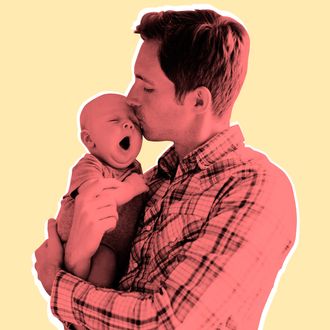
Paternity leave still hasn’t made it as a platform issue this election season, but, in recent months, some major companies and personalities have at least brought the issue into the spotlight. Last summer, for example, Netflix announced it would offer moms and dads up to a year of parental leave; more recently, Mark Zuckerberg took two months off from his Facebook duties after the birth of his daughter, Max.
And yet, for most American men, the reality is that a baby’s grand entrance usually just means a few days off the job before he’s back at work. As Daily Intelligencer’s Annie Lowrey wrote last August, the answer isn’t as simple as implementing more generous paternity-leave policies, as Netflix has done. “They need to use them,” Lowrey wrote. “It needs to become normal for men to take weeks or months off, and to require more flexible schedules to accommodate their new family member’s needs when they return.”
The question then becomes: Just how do you do that? According to Gordon Dahl, an economist at the University of California, San Diego, the solution may at least partially be a simple case of copycat. Dahl’s research, recently summarized by NPR, looked to Norway for inspiration, which has a generous leave policy enacted in 1993, when the country offered new papas an additional four weeks of leave. Before the law, Norwegian dads were taking the same amount of time off as their American counterparts, about 3 percent. But after 1993, things flipped, and suddenly about 35 percent of Norwegian dads were taking leave.
That’s remarkable, but Dahl saw something else that was perhaps surprising: Over the next couple of decades, more and more fathers were taking paid leave, with about 70 percent of new fathers declaring leave the last year of Dahl’s study, 2011. Something else was nudging these dads to take leave, and Dahl finally figured out what: other dads.
It’s a classic case of monkey see, monkey do, particularly for private-sector dads who saw other fathers coming back to the workplace with nary a problem. “If you had a co-worker take leave, then you’re 11 percentage points more likely to take leave yourself when you have your child,” Dahl said. “If you have a brother who took leave, you’re 15 percentage points more likely to take leave. These are not small effects. These are big increases in how many people are willing to take leave.”
Of course, parental-leave laws in America might be to blame for that nervous anxiety dads might have about taking paternity leave. Nationally, federal law requires that companies with at least 50 employees offer 12 weeks of unpaid leave. According to National Conference of State Legislatures data used by NPR, only three states — California, New Jersey, and Rhode Island — offer paid family leave, funded through payroll taxes. Unless you’re at a larger company or in one of these three states, dads have reason to be leery of taking time off to take care of a new baby.
Still, there is reason to believe the U.S. might be in the midst of a mental mind-set change among new fathers willing — and, importantly, able — to take paternity leave. A 2014 study suggested millennial dads strongly consider paid leave an important issue. California, where paid leave has been available since 2004, is ground zero for the American version of this test, and things seem to be slowly going the Norwegian route. In 2004, 17 percent of new fathers in California took advantage of paid leave; within five years, that number had climbed to 26 percent. With those kinds of numbers in just one state, who knows what would happen if paid leave were implemented nationwide?




